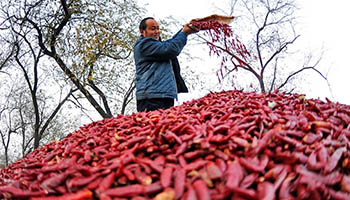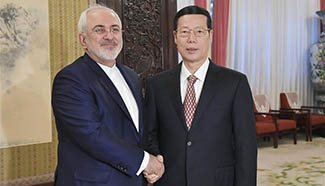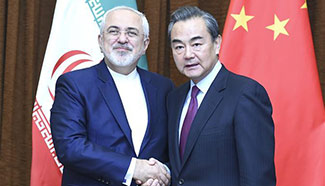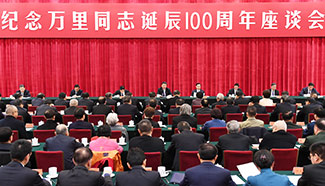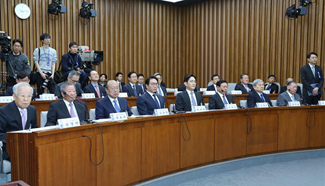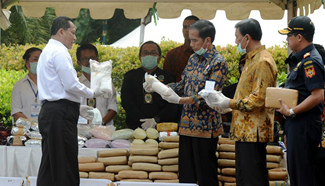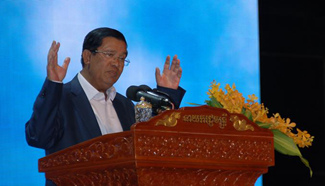BEIJING, Dec. 6 (Xinhua) -- The Chinese government published its first white paper on traditional Chinese medicine (TCM) Tuesday, detailing policies and measures on TCM development and highlighting its unique value in a new era.
"TCM has created unique views on life, on fitness, on diseases and on the prevention and treatment of diseases during its long history of absorption and innovation," said the white paper, Traditional Chinese Medicine in China, published by the State Council Information Office.
As ideas on fitness and medical models change and evolve, traditional Chinese medicine has become more and more profound in its value, the document said.
"TCM has been comprehensively developed in China which is now able to offer health services covering the life cycle of citizens," said Wang Guoqiang, director of the State Administration of Traditional Chinese Medicine.
TCM and Western medicine have different strengths. They work together in China to protect people from diseases and improve public health. This has turned out to be a unique feature in the development of China's medical and health sector, Wang said.
Hailing the establishment of a TCM medical care system, covering both urban and rural areas in China, the white paper said there were 3,966 TCM hospitals, 42,528 TCM clinics and 452,000 practitioners and assistant TCM practitioners across the country by 2015.
In addition to making contributions to the prevention and treatment of common, endemic and difficult diseases, TCM has played an important role in the prevention and treatment of major epidemics, such as SARS, HIV/AIDS, as well as Hand, Foot and Mouth Disease, it said.
TCM also played an important role in the reform of the medical care system, according to the white paper.
With relatively low cost, TCM has contributed rather a higher share of services in relation to the resources it has received, it said.
The medical care services provided by TCM institutions increased from 14.3 percent to 15.7 percent from 2009 to 2015, according to official statistics.
In 2015, out-patient expenses per visit and in-patient expenses per capita at public TCM hospitals were 11.5 percent and 24 percent lower than those at general public hospitals, respectively.
There were 910 million visits in 2015 to TCM medical and health service units across the country.
China has established a modern Chinese medicine industry based on the production of medicinal materials and industrial production, tied together by commerce, said the white paper, while also noting the rapid development of TCM pharmaceuticals.
A number of laws and regulations have been passed to protect TCM medicinal resources in the wild; and artificial production or wild tending has been carried out for certain scarce and endangered resources, the document said.
To date, 60,000 TCM and ethnic minority medical drugs have been approved, and 2,088 pharmaceutical enterprises that have been approved by the Good Manufacturing Practice of Medical Products to manufacture Chinese patent medicines.
In 2015, the total output value of the TCM pharmaceutical industry was 786.6 billion yuan (114.21 billion U.S. dollars), accounting for 28.55 percent of the country's pharmaceutical industry, making it a new source of growth in China's economy.
TCM DEVELOPMENT A NATIONAL STRATEGY
Wang stressed the need for comprehensive reform of TCM, including supply-side structural reform, to lift service capability, noting disharmony between TCM and existing laws, policies and institutions.
Elaborating the country's policies and measures to promote TCM development, Tuesday's white paper said China has made TCM development "a national strategy."
A series of major policy decisions have been made, and a number of plans have been adopted to promote TCM development since the Communist Party of China's (CPC) 18th National Congress in 2012.
In 2015, the executive meeting of the State Council approved a draft Law on Traditional Chinese Medicine, submitting it to the top legislature for approval, intending to provide a more sound policy environment and legal basis for TCM.
In 2016, the CPC Central Committee and the State Council issued the Outline of the Healthy China 2030 Plan, a guide to improving the health of the Chinese people in the next 15 years.
In the same year, the State Council issued the Outline of the Strategic Plan on the Development of Traditional Chinese Medicine (2016-2030), which makes TCM development a national strategy, with plans to develop TCM in the new era.
The white paper described these plans as "a grand blueprint" that focuses on the full revitalization of TCM, saying they ushered in a new era of development for TCM.
Stressing the innovative development of TCM for health preservation, the white paper said China aspires to enable every Chinese citizen to have access to basic TCM services by 2020, and make TCM services cover all areas of medical care by 2030.
Meanwhile TCM is going global, with the white paper saying TCM has spread to 183 countries and regions around the world.
In the past, international exchanges were basic, but now substantive cooperation at the operational level of TCM is taking shape, said Zhang Boli, president of the China Academy of Chinese Medical Sciences.
According to the World Health Organization, 103 member states have given approval to the practice of acupuncture and moxibustion, 29 have enacted special statutes on traditional medicine, and 18 have included acupuncture and moxibustion treatment in their medical insurance provisions.
"TCM offers a valuable reference to other parts of the world in terms of curbing the fast growth of medical expenses to make medical care affordable," Wang said.
At present, governments of 86 countries and regions have signed agreements for TCM cooperation with China as TCM gains more popularity and recognition globally, Wang said.
Related:
Full text: Traditional Chinese Medicine in China
BEIJING, Dec. 6 (Xinhua) -- China's State Council Information Office on Tuesday issued a white paper on the development of traditional Chinese medicine (TCM) in China. Full story




